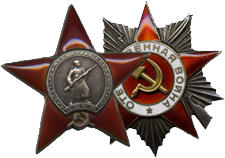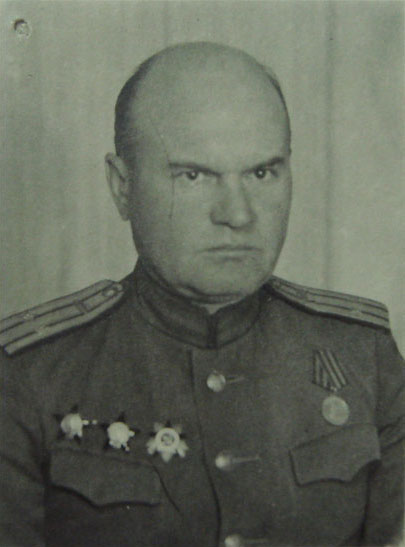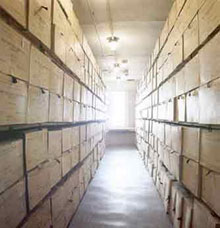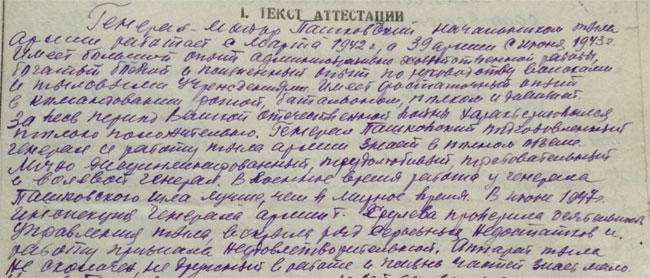|
Researching Soviet awards
Many serial numbered Soviet military orders and medals from World War Two are attributable. Using their serial number (or the name of the recipient, if available), they can be researched in the Central Archive of the Ministry of Defense of the Russian Federation (TsAMO RF). Based in Podolsk, a large city about 40 kilometers south of Moscow, this archive stores millions of military records about the ground and air forces of the former Soviet Union and the Russian Federation. Its naval equivalent, the Central Navy Archive (TsVMA) in Gatchina, some 100 kilometers southwest of Saint Petersburg, stores a significant portion of the archival documents concerning Navy personnel. A century of Soviet and Russian military history is preserved in these vast archives. Among other things, they contain award citations and biographical documents on most recipients of serial numbered military decorations. Adding a name, story, and often even a face to a piece of metal, brings the long-forgotten stories back to life and really makes collecting awards considerably more interesting. Have a look at the page here for a selection of my research results (translated into English). Details
The following awards can be researched:
Procedure As said, archival research can be done using either the serial number of an award or the name of the recipient. So, generally speaking, an unnumbered award can be researched if the name of the recipient is known (for example through the award document). However, especially if the recipient has a common name, it is possible that multiple persons with the name in question can be found in the archive. As more details are known about the recipient, the chances of success increase. Postwar unnumbered Medals for Courage and Medals for Combat Merit with their award document for instance are perfectly suitable for archival research, because in these cases the award date (the prikaz or ukaz date) is usually entered in the award document.
There are several reasons why awards can turn out to be unresearchable:
Documents
Pictured here are the four most common archive documents. The first two photos show the obverse and reverse of the uchotnaya kartochka (record card, also known as award card), providing a number of the soldier's biographical and military career details. The reverse contains a list of all the individual's serial numbered awards, and sometimes (some of) their unnumbered medals too.
The third and fourth image show both sides of the nagradnoi list (award sheet or award citation), a document nominating an individual for a certain award. It contains a description of the feat of arms for which the prospective recipient should be given the award (the actual citation part) and it lists several military career details.
The fifth and sixth photo show the first and last page of the prikaz (order), which officially bestowed the decoration once the award sheet was processed and approved by an officer authorized to award the order or medal. Often in the case of late-war Medals for Courage and Medals for Combat Merit, no separate award sheets were drawn up for these medals, and in these cases the citations were inserted directly into the order.
The final two pictures show the uchotno-posluzhnaya kartochka (service record), containing a number of biographical and military career details. Among other things, it lists the officer's promotions, his awards, the military courses he attended, and the names of his next of kin. The reverse shows all assignments and often has a picture of the recipient. The service record is only available for officers. Finally, there is the lichnoye delo (personnel file), a folder with sometimes just a few documents and sometimes dozens of them. It often contains an autobiography, a list of all assignments, attestations, promotion recommendations, et cetera. Depending on the length of service and rank attained, the personnel file can vary in size considerably. It is only available for officers. Of all documents, many variations exist, but the ones mentioned above are the most common ones. From time to time, not all documents are available, for various reasons, some of which are mentioned above. Obtaining research Have a look at this page if you want to have one of your Soviet awards researched. Translations I do not do full translations myself, but if desired I can assist in deciphering the Russian text or interpeting the military jargon. These documents were drawn up three quarters of a century ago using an archaic military jargon and many abbreviations and acronyms. Moreover, delicate onionskin paper was used for many of these documents, and they were usually drawn up by hand, which poses further challenges. And to make matters worse, many citations were written up by clerks with limited education and it is not uncommon for the documents to contain grammatical and spelling errors. For your enjoyment I have shown some examples of "deciphering challenges" below, combining all these translating difficulties:
| |||||||||||||||||||||||||||||||
All rights reserved / alle rechten voorbehouden © Auke de Vlieger 2008-
Home


















